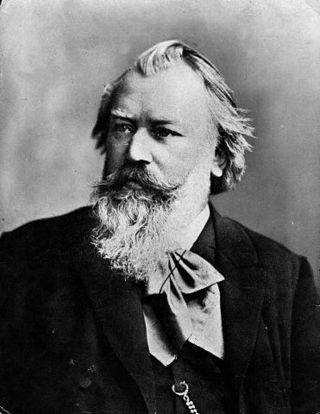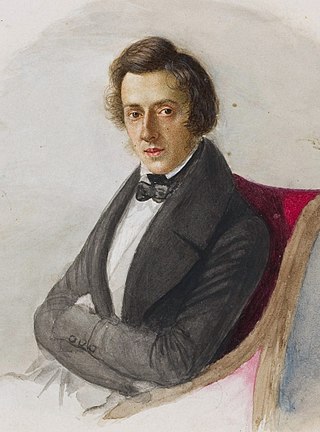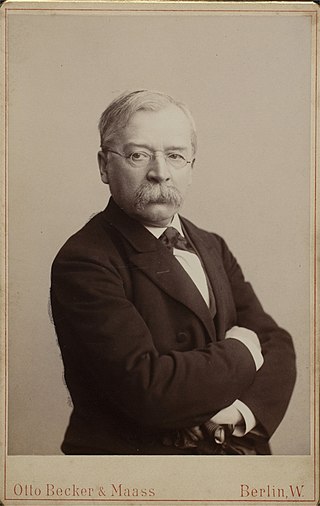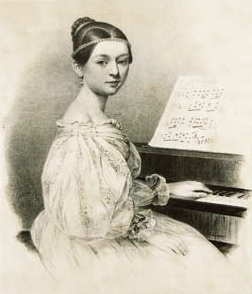Related Research Articles

Johannes Brahms was a German composer, pianist, and conductor of the mid-Romantic period. Born in Hamburg into a Lutheran family, he spent much of his professional life in Vienna. He is sometimes grouped with Johann Sebastian Bach and Ludwig van Beethoven as one of the "Three Bs" of music, a comment originally made by the nineteenth-century conductor Hans von Bülow.

The Piano Concerto in A minor, Op. 54, by the German Romantic composer Robert Schumann was completed in 1845 and is the composer's only piano concerto. The complete work was premiered in Dresden on 4 December 1845. It is one of the most widely performed and recorded piano concertos from the Romantic period.

The Piano Concerto No. 2 in B♭ major, Op. 83, by Johannes Brahms is separated by a gap of 22 years from his first piano concerto. Brahms began work on the piece in 1878 and completed it in 1881 while in Pressbaum near Vienna. It took him three years to work on this concerto, which indicates that he was always self-critical. He wrote to Clara Schumann: "I want to tell you that I have written a very small piano concerto with a very small and pretty scherzo." Ironically, he was describing a huge piece. This concerto is dedicated to his teacher, Eduard Marxsen. The public premiere of the concerto was given in Budapest on 9 November 1881, with Brahms as soloist and the Budapest Philharmonic Orchestra, and was an immediate success. He proceeded to perform the piece in many cities across Europe.

The Piano Quintet in E-flat major, Op. 44, by Robert Schumann was composed in 1842 and received its first public performance the following year. Noted for its "extroverted, exuberant" character, Schumann's piano quintet is considered one of his finest compositions and a major work of nineteenth-century chamber music. Composed for piano and string quartet, the work revolutionized the instrumentation and musical character of the piano quintet and established it as a quintessentially Romantic genre.
The Piano Quintet in F minor, Op. 34, by Johannes Brahms was completed during the summer of 1864 and published in 1865. It was dedicated to Her Royal Highness Princess Anna of Hesse. As with most piano quintets composed after Robert Schumann's Piano Quintet (1842), it is written for piano and string quartet.

The Piano Sonata No. 2 in B♭ minor, Op. 35, is a piano sonata in four movements by Polish composer Frédéric Chopin. Chopin completed the work while living in George Sand's manor in Nohant, some 250 km (160 mi) south of Paris, a year before it was published in 1840. The first of the composer's three mature sonatas, the work is considered to be one of the greatest piano sonatas of the literature.
The Symphony in C major by German composer Robert Schumann was published in 1847 as his Symphony No. 2, Op. 61, although it was the third symphony he had completed, counting the B-flat major symphony published as No. 1 in 1841, and the original version of his D minor symphony of 1841. It is dedicated to Oscar I, king of Sweden and Norway.

Woldemar Bargiel was a German composer and conductor of the Romantic period.
The F-A-E Sonata, a four-movement work for violin and piano, is a collaborative musical work by three composers: Robert Schumann, the young Johannes Brahms, and Schumann's pupil Albert Dietrich. It was composed in Düsseldorf in October 1853.

The Symphony No. 1 in B♭ major, Op. 38, also known as the Spring Symphony, is the first completed symphonic work composed by Robert Schumann.
The Piano Sonata in G major D. 894, Op. 78 by Franz Schubert is a sonata for solo piano, completed in October 1826. The work is sometimes called the "Fantasie", a title which the publisher Tobias Haslinger, rather than Schubert, gave to the first movement of the work. It was the last of Schubert's sonatas published during his lifetime, and was later described by Robert Schumann as the "most perfect in form and conception" of any of Schubert's sonatas. A typical performance runs approximately 35 minutes.
The Piano Sonata No. 2 in F♯ minor, Op. 2 of Johannes Brahms was written in Hamburg, Germany in 1852, and published the year after. Despite being his second published work, it was actually composed before his Piano Sonata No. 1 in C major, but was published later because Brahms recognized the importance of an inaugural publication and felt that the C major sonata was of higher quality. It was sent along with his first sonata to Breitkopf und Härtel with a letter of recommendation from Robert Schumann. Schumann had already praised Brahms enthusiastically, and the sonata shows signs of an effort to impress, with its technical demands and highly dramatic nature. It was dedicated to Clara Schumann.
The Piano Sonata No. 2 in G minor, Op. 22 was composed by Robert Schumann from 1830 to 1834.

The Piano Quartet in E♭ major, Op. 47, was composed by Robert Schumann in 1842 for piano, violin, viola and cello. Written during a productive period in which he produced several large-scale chamber music works, it has been described as the "creative double" of his Piano Quintet, finished weeks earlier. Though dedicated to the Russian cellist Mathieu Wielhorsky, it was written with Schumann's wife Clara in mind, who would be the pianist at the premiere on 8 December 1844 in Leipzig.

The Violin Sonata No. 2 in A major, Op. 100, by Johannes Brahms was written while spending the summer of 1886 in Thun in the Bernese Oberland, Switzerland.
The Piano Trio in A major, sometimes attributed to Johannes Brahms as Anh. 4/5, is scored for piano, violin and cello. Brahms is reported to have destroyed many of his works that did not meet his own high standards. This piano trio may be one of the exceptions to have survived.
Composed in 1846, the Piano Trio in G minor, opus 17 by Clara Schumann is considered her greatest, most mature four-movement work. It is her only piano trio, composed while she lived in Dresden, following extensive studies in fugue writing and the publication of her Three Preludes and Fugues For Piano, opus 16 in 1845. The trio was premiered by the composer in Vienna on January 15th, 1847.
From March 1816 to August 1817, Franz Schubert composed four violin sonatas. All four were published after the composer's death: the first three, D 384, 385 and 408, as Sonatinas in 1836, and the last one, D 574, as Duo in 1851. Schubert composed two more pieces for violin and piano, in October 1826 and December 1827 respectively: a Rondo, D 895, which was published during the composer's lifetime (Op. 70), and a Fantasy, D 934, which was premiered in January 1828, less than a year before the composer's death.

The Piano Sonata No. 1 in F♯ minor, Op. 11, was composed by Robert Schumann from 1833 to 1835. He published it anonymously as "Pianoforte Sonata, dedicated to Clara by Florestan and Eusebius".

The Piano Concerto in A minor, Op. 7, was composed by Clara Wieck, better known as Clara Schumann after her later marriage to Robert Schumann. She completed her only finished piano concerto in 1835, and played it first that year with the Leipzig Gewandhaus Orchestra, conducted by Felix Mendelssohn.
References
- Sources
- Anderson, Keith (2002). Robert Schumann Piano Sonatas No.1 & 3 (CD). Naxos Records. 8.554275.
- Donat, Mischa (1996). Robert Schumann: Piano Sonatas (PDF) (CD). Hyperion Records. CDH55300.
- Haywood, Tony (2002). "Review: Robert Schuman Piano Sonatas No. 1 & 3 (Naxos 8.554275)". Musicweb International.